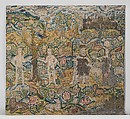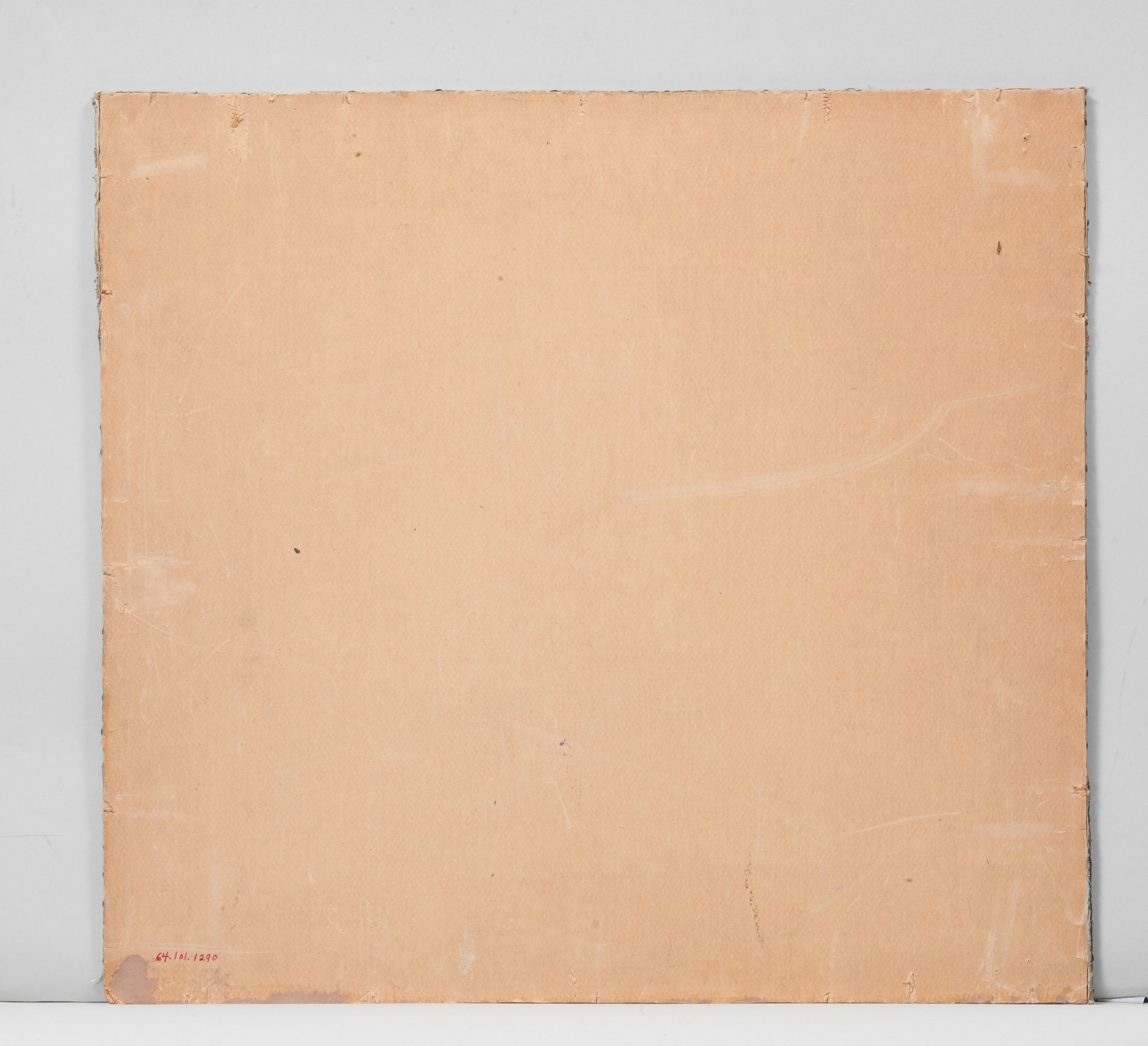Adam and Eve with Charles I and Henrietta Maria
Not on view
The imagery of this panel is unusual in that it juxtaposes King Charles I and his consort, Henrietta Maria, with Adam and Eve beneath the Tree of Knowledge. To some extent, the panel can be classified with other commonly occurring images of the royal couple in contemporary embroidery. These appear to have been primarily celebratory or commemorative in nature, but the direct association made here between contemporary royalty and Adam and Eve is unique among surviving embroidered pictures, indeed among the images of royalty in every medium. It therefore has significance within the wider field of royal iconography of the Caroline era.
The embroidery can be dated to a time after 1634, because the poses of Charles I and Henrietta Maria are derived from an engraving by Robert van Voerst first published in that year. The print shows Charles and Henrietta Maria exchanging olive and laurel branches, emblems of peace and military glory, and it celebrates their marriage and the political advantages that accrued from it. The print is a copy of the painting by Anthony van Dyck of 1632, which itself is a reworking of an original by Daniel Mytens of ca. 1630–32.
This association between royal marriage and royal authority is carried over into the embroidery, although apart from the poses of the royal couple, it retains little of the symbolism of its prototype. In place of the exchange of olive and laurel branches between the royal couple, Henrietta Maria offers her husband a flower, while Charles holds a sword and scepter, the symbols of worldly dominion. The association of the royal marriage and Charles’s symbols of monarchy with Adam and Eve, the first married couple, carries the suggestion that Charles’s claim to royal authority rests on a chain of royal—specifically familial—descent stretching back to the Fall and even before that, to humankind’s state of innocence. Such a juxtaposition would have resonated in the 1630s and 1640s with the political debates that raged over the nature of political authority. In these debates, the varied justifications for political organization, whether Royalist, Parliamentarian, or Leveller, were invariably based on some understanding of Adamic patriarchy and the first marriage. For all political complexions, the concept of Paradise that had once existed in some place and time provided the key to the way in which ideal social relations once were and should still be.
The theme of the panel appears to be an explicit reflection of the Royalist argument, which saw Adamic patriarchy as the basis of the divine right of kings. In The Glasse of Time (1620), Thomas Peyton described James I as "A royall King deriued from the race, / O f Edens Monarch in her greatest grace, / Within whose face true Maiesty doth shine." According to Richard Cumberland, a friend of Samuel Pepys, "Humankind, and by consequence, all Societies and Families sprang from the matrimonial Union of one Man with one Woman. And, consequently, all Civil Government is originally laid out in a natural Parental Authority" (De Legibus Naturae, 1672). Such arguments and their counter-arguments, which maintained that the right to govern derived from the consent of the people, were furiously debated during the crisis of Parliament and the Civil War years of the 1640s. John Maxwell, chaplain to Charles I, argued in Sacro-Sancta Regum Majestas (1644) that monarchy was fixed by God in the time before the Fall. "Can we be so stupid as to acknowledge the dominion over all creatures below is given to man immediately by God, and to deny that the most noble and excellent Government by which man hath Power and Empire over men is not from God . . . but by Compact and Contract, the Composition and Constitution of men?" Sir Robert Filmer, in his Patriarcha: or, The Natural Right of Kings (probably written about 1630, but not published until 1680), justified monarchy on hereditary grounds—that Adam and the patriarchs after him had royal authority over their children by right of fatherhood, and that this authority had been given to them by God. "The first Father had not only simply power, but power monarchical, as he was a Father immediately from God. For by the appointment of God, as soon as Adam was created he was monarch of the world, though he had no subjects." For Filmer, Adam’s was "[a]s large and ample as the Absolutest Dominion of any Monarch which hath been since the Creation."
Such views reached the popular domain via sermons and pamphlets. John Evelyn recorded in a diary entry of May 1678 having heard a sermon that argued for the monarchical over all other systems of government, "& that from Adam (to whom God had given the Empire of all things & Persons) that it seemed to be not onely of divine, but most natural institution." And on January 30, 1694, the anniversary of the death of Charles I, Evelyn heard a young man preach on the "Excellency of Kingly Government above all other, deriving it from Adam, The Patriarchs, God himselfe." The panel therefore shows an embroiderer directly engaged in these debates, asserting sympathy for the Royalist cause. As such, it shows the expressive freedom of the embroidery medium, which because of its relatively private nature allowed its makers to react personally to events and to create images encompassing themes that lay outside and beyond the iconographical norms of public art, both popular prints and the more exclusive iconography of the court.
[Andrew Morrall, adapted from English Embroidery from The Metropolitan Museum of Art, 1580-1700: 'Twixt Art and Nature / Andrew Morrall and Melinda Watt ; New Haven ; London : Published for The Bard Graduate Center for Studies in the Decorative Arts, Design, and Culture, New York, The Metropolitan Museum of Art, New York [by] Yale University Press, 2008.]
This image cannot be enlarged, viewed at full screen, or downloaded.
This artwork is meant to be viewed from right to left. Scroll left to view more.





